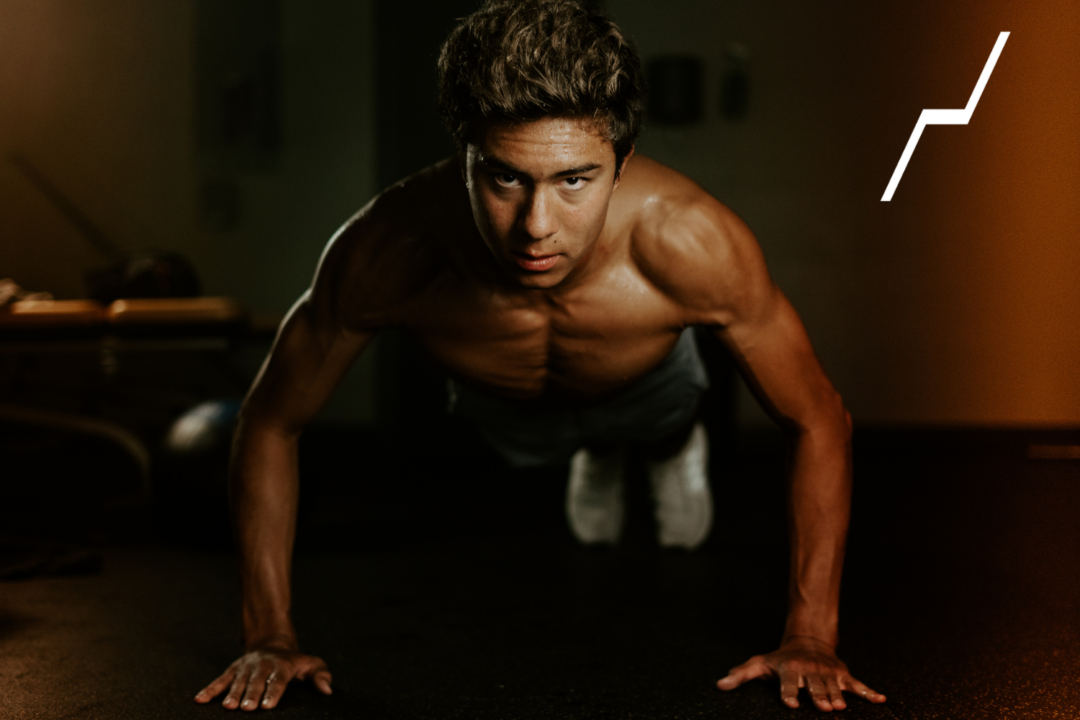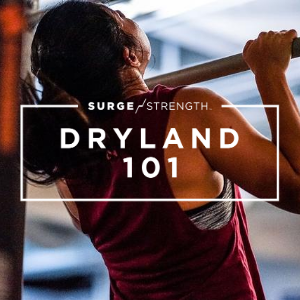Upper body exercises that fall into the category of “push” are essential to any dryland plan. That’s because they build the strength a swimmer needs to propel themselves through the water faster. Despite the benefits, some coaches steer away from pushing exercises because of the prevalence of shoulder injuries in the sport of swimming. With any of our SURGE Strength Programs, our Dryland Certified Coaches always advocate for better implementation and progression of dryland pushing exercises for swimmers within a dryland plan in order to mitigate this fear.
- Want to Join Us in Helping Raise the Standard of Dryland Training? Learn More – Become SURGE Strength Dryland Certified (SSDC)
What’s ironic about the shoulder injury misconception is that when push exercises are properly executed and tailored to the swimmer’s current ability, they reduce the chance of shoulder injuries in the pool. This is because pushing requires a decent amount of both shoulder mobility and strength to execute properly. Also, push exercises promote better core bracing. By training the push in dryland, swimmers have a larger range of motion (ROM) and better stabilization in the shoulder joint. In turn, they can train through a swim season with their shoulder capsule intact.
Unpacking the Push
There are two types of pushing in dryland: horizontal and vertical. Horizontal pushing exercises are usually performed in a supine position (think chest presses), or a prone position (think push-ups). Horizontal presses primarily target the chest, back of the arms, and anterior shoulder.
In comparison, vertical presses are typically performed seated or standing (think overhead pressing variations). Vertical pushes concentrate on recruiting the entire shoulder capsule and demand a significant amount of trunk stability. This keeps the body upright as the load is moved overhead.
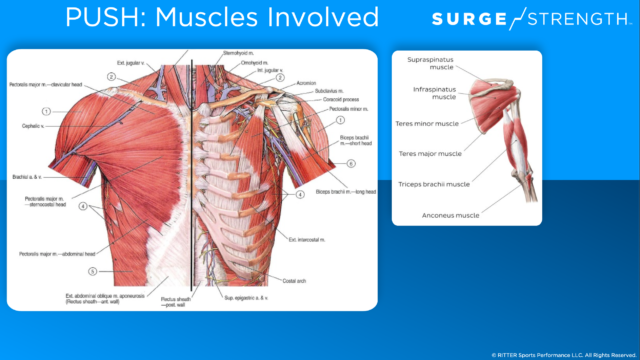
Pushing Prerequisites
In both horizontal and vertical presses, core strength is a nonnegotiable prerequisite. In order to produce enough tension to push the body away from a load safely, the entire trunk must remain stable and engaged. A good way to check your swimmer’s core bracing is to see if their head, shoulders, hips, and toes are in alignment during core exercises such as planks. By assessing core exercises first, swimmers learn how to translate core bracing patterns into an athletic pressing movement.
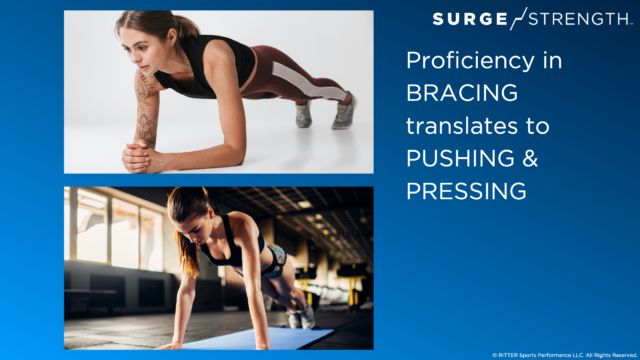
Pushing Posture
During any pushing movement, posture should be kept at the forefront of the mind in order to prevent injury. Without it, there will be much less benefit from these exercises in a dryland plan. If swimmers do not have the ability to move their body into a safe and stable position, they should not continue pressing exercises.
Swimmers who lack mobility compensate for their forward shoulder posture by pressing a load with compromised form. As a result, they are likely to develop upper cross syndrome. This condition results in weak neck and shoulder stabilizers and tight upper back and pectoral muscles. In turn, you will see the swimmer’s posture out of alignment with the head jutting forward and scapula winging outward. Pressing in this state will easily cause more shoulder pain and injury because of the already weak upper back, shoulder, and neck muscles absorbing more load than they should in a pressing movement.
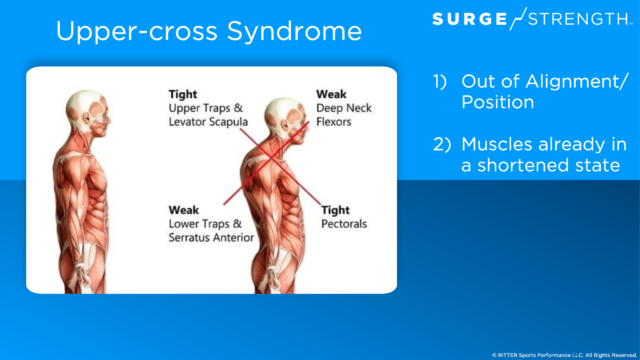
Stronger Shoulders
If you suspect that your athlete has upper cross syndrome, or if their posture is simply less than ideal, focus on isolating the shoulder joint before advancing them to pushing exercises. First, focus on increasing the ROM at the scapula. Then, work on strengthening the rotator cuff muscles with shoulder prehabilitation exercises.
To better understand the importance of a strong shoulder capsule in relation to pressing exercises, listen to the SURGE Strength approach to shoulder mobility and stability below:
Progressing the Push
We categorize pushing exercises into 3 levels: grooving the push, loading the push, and overloading the push. In level 1, swimmers focus on bracing their core and maintaining body alignment in a pushing position. In level 2, they perform presses both in front of their body and overhead. Level 3 is intended to challenge multiple training variables within a pressing movement. Check out some of our favorite variations for each progression of the push below:
Dryland Pushing Exercises for Swimmers – Level 1
Groove the Push
Once swimmers have trained the brace and have no contraindications to training the muscles around the shoulder joint, they are ready for level 1 pushing exercises. These movements teach swimmers what proper alignment looks and feels like as they absorb force. See two of our favorite Level 1 exercises below:
A) Drop-Down Push-up
The drop-down push-up is a great eccentric exercise for both beginners and experienced athletes. This movement increases the swimmer’s body awareness in the push-up position as they descend to the floor. The anterior chest and shoulders absorb force as the core braces to maintain proper alignment. Once swimmers can perform about 5 consecutive drop-down pushups with good form, they are ready for level 2.
- Eccentric – muscular contraction where fibers are lengthening to absorb force
B) Waiter Carries
Waiter carries are isometric exercises that challenge the shoulder to resist moving out of the desired position. Therefore, they are great for athletes of all training ages to practice. In order to maximize results from this movement, the weight should be challenging. For the waiters carry in particular, the swimmer will need both hands to press the dumbbell overhead and catch it on the way back down. Training the correct overhead body position through carry variations is essential for more advanced vertical pressing exercises. And as always, make sure that your athletes are using appropriate weight.
- Isometric – muscular contraction where fibers are working to hold a position
Dryland Pushing Exercises for Swimmers – Level 2
Load the Push
Once your swimmers have mastered level 1 push variations, they are ready to advance to level 2. Level 2 movements require athletes to press the load rather than just maintaining body alignment. Due to the amount of core recruitment transferring load across the body, level 2 exercises could be considered total body exercises. Think of the hip drive required in a push press. Consider the tension in the legs as you press the feet into the floor during a bench press. This action translates well to swimming as athletes use their kick to help them move forward with each stroke. We reinforce the kinetic chain with our favorite Level 2 pushing exercises below.
A) Hands-Up Push-up
The hands-up push-up is one of our favorite push-up variations. This is because swimmers lift their hands up at the bottom of the rep to reestablish proper shoulder alignment in the press. This is a great option for athletes who have the tendency for developing upper cross syndrome as described above.
B) Push Press
Push presses are also an excellent vertical pushing exercise for a level 2 athlete. In addition to training the upper body, push presses also incorporate hip drive and lower body power. This movement translates well into starts and turns as movement initiates from the hips.
Dryland Pushing Exercises for Swimmers – Level 3
Overload the Push
Once your swimmers are progressively overloading level 1 and 2 exercises, they are ready for level 3. Level 3 pressing exercises incorporate other training variables such as power or complexity. See an example of how we incorporate an upper body plyometric exercise below.
A) Power-Push-up
The power-push-up is a great way to train the fast twitch muscles of the chest and arms. With each stroke through the water, the front of the body will need fast twitch power to push the swimmer through the density of the water. Once athletes have mastered loaded push-ups, challenge them with this fun, simple, and effective variation.
If you have been shying away from exercises that fall into the push category, we understand why. There is a lot of fear around injuries and protecting swimmers’ shoulders. We are on the same page about that. If you take anything away from this article, we hope it’s that push exercises, when done with proper posture and at proper weight, help to prevent injuries by strengthening the shoulder. That’s why we recommend starting with a few Level 1 exercises. Then, take athletes through the progression regardless of their current ability. This way, you know they are performing exercises properly and not overloading their shoulders with too much volume.
Consider sprinkling 1-2 vertical and horizontal presses into each dryland session. Over time, you will notice better posture when combined with adequate amounts of pulling exercises. In addition, your team will see less swim-related shoulder pain. Most importantly, your swimmers will be stronger athletes. Stronger athletes are faster swimmers.
Want more on the push? Check out our Instagram @surge.strength.
We’re running a bi-monthly initiative called Dryland Certified Technique Tuesday where we showcase our community working towards better form! The month of January is entirely dedicated to the push.
JOIN OTHERS FROM AROUND THE WORLD THAT ARE
BECOMING SURGE STRENGTH DRYLAND CERTIFIED (SSDC)
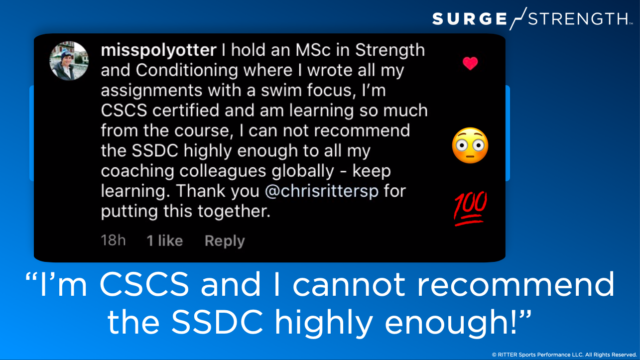
NEW – AT HOME DRYLAND WORKOUT
GET IT FOR FREE BY ENROLLING IN THE SURGE STRENGTH ACADEMY
BECOME SURGE STRENGTH DRYLAND CERTIFIED (SSDC)
BUILD BETTER ATHLETES TO GENERATE FASTER SWIMMERS
Courtesy of SwimSwam’s exclusive dryland training partner, SURGE Strength.
SURGE Strength, a strength training brand created by Chris Ritter, CEO of RITTER Sports Performance, aims to build better athletes and faster swimmers through dryland programs, and coaching education.
